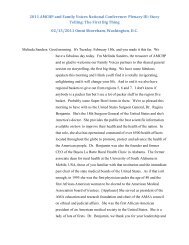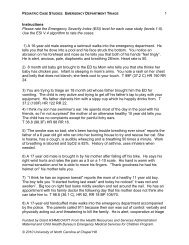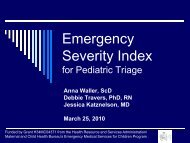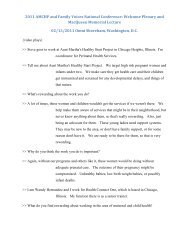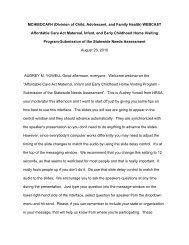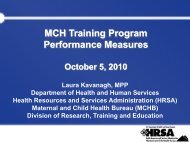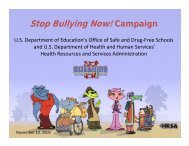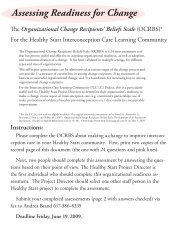Hormone Disruptors and Women's Health: Reasons for Concern [PDF]
Hormone Disruptors and Women's Health: Reasons for Concern [PDF]
Hormone Disruptors and Women's Health: Reasons for Concern [PDF]
Create successful ePaper yourself
Turn your PDF publications into a flip-book with our unique Google optimized e-Paper software.
What We Can Do<br />
We know enough about hormone disruptors to know we have a problem. A coordinated ef<strong>for</strong>t between researchers, elected<br />
officials, advocates, medical professionals, business leaders <strong>and</strong> the general public is needed to ensure that we are not putting<br />
our families <strong>and</strong> future generations at undue risk. Some of the things we can do are:<br />
Support better research on hormone disruptors, including:<br />
• Prioritize research funding to study the effects of hormone disruptors on women’s health. Most of the research to date has been<br />
focused on hormone disruptors <strong>and</strong> men, leaving more gaps in the research on women’s health.<br />
• Improve health tracking systems. Currently the systems that track rates of various health problems are inadequate. In order<br />
to underst<strong>and</strong> the full impact of hormone disruptors on human health, collecting this in<strong>for</strong>mation is critical.<br />
• Support long-term studies. Because hormone disruptors can have lifelong impacts, it is especially important to initiate studies<br />
tracking women’s health over large spans of their lives. This will help us underst<strong>and</strong> longterm <strong>and</strong> multigenerational<br />
effects.<br />
Support policies to prevent exposure to hormone disruptors <strong>and</strong> other chemicals that have not been proven<br />
safe. Current st<strong>and</strong>ards <strong>for</strong> chemical use do not adequately protect us. New national policies are needed to identify <strong>and</strong><br />
phase out harmful chemicals <strong>and</strong> to require that safer substitutes be used.<br />
Use healthier products when possible. There are many easy, af<strong>for</strong>dable <strong>and</strong> simple changes anyone can make at<br />
home to reduce their exposure to environmental contaminants. For ideas on how to make these changes, please see<br />
www.womenshealth<strong>and</strong>environment.org.<br />
References<br />
References <strong>for</strong> this report were taken from peerreviewed<br />
sources that summarize the links between hormone disruptors<br />
<strong>and</strong> women’s heath. The primary source was:<br />
Crain, AD, Janssen, S. et al. Female reproductive disorders:<br />
The roles of endocrine disrupting compounds <strong>and</strong><br />
developmental timing. Fertility <strong>and</strong> Sterility; expected<br />
publication Fall 2008.<br />
Other references used to support the development of<br />
this report include:<br />
Proceedings from the Summit on Environmental Challenges<br />
to Reproductive <strong>Health</strong> <strong>and</strong> Fertility. Hosted by<br />
the University of Cali<strong>for</strong>nia, San Francisco <strong>and</strong> the Collaborative<br />
on <strong>Health</strong> <strong>and</strong> the Environment. Fertility<br />
<strong>and</strong> Sterility 2008;89:e1e20. www.prhe.ucsf.edu/prhe/<br />
events/ucsfche_fs.html.<br />
Shaping Our Legacy: Reproductive <strong>Health</strong> <strong>and</strong> the Environment.<br />
A report on the Summit on Environmental<br />
Challenges to Reproductive <strong>Health</strong> <strong>and</strong> Fertility, January<br />
28–30, 2007. www.prhe.ucsf.edu/prhe/pubs/shapingourlegacy.pdf.<br />
These <strong>and</strong> many other resources document how hormone<br />
disruptors <strong>and</strong> a wide range of other contaminants<br />
can harm people’s health. For full documentation<br />
of this brochure, see www.health<strong>and</strong>environment.org/<br />
reprohealthworkshop.<br />
This report summarizes the key outcomes of the Women’s Reproductive <strong>Health</strong> <strong>and</strong> the<br />
Environment Workshop held at Commonweal in Bolinas, CA, January 6–9, 2008. Results<br />
are published in “Female reproductive disorders: The roles of endocrine disrupting compounds<br />
<strong>and</strong> developmental timing.” (See References <strong>for</strong> full citation).<br />
The workshop was cosponsored by the Collaborative on <strong>Health</strong> <strong>and</strong> the Environment<br />
(CHE), the University of Florida (UF) <strong>and</strong> the University of Cali<strong>for</strong>nia, San Francisco’s Program<br />
on Reproductive <strong>Health</strong> <strong>and</strong> the Environment (PRHE). This event was cochaired<br />
by Dr. Louis Guillette at UF (www.zoology.ufl.edu/ljg) <strong>and</strong> Dr. Linda Giudice at PRHE<br />
(www.prhe.ucsf.edu). Please contact these individuals <strong>for</strong> further in<strong>for</strong>mation about this<br />
research. Thanks to Sarah Janssen of Natural Resources Defense Council <strong>for</strong> contributing<br />
to this brochure. Written by Heather Sarantis.<br />
Funding <strong>for</strong> this project was provided by John Burbank <strong>and</strong> Alison Carlson, the Barbara<br />
Smith Fund, the Johnson Family Foundation, The New York Community Trust <strong>and</strong> Turner<br />
Foundation, Inc.<br />
For copies of this brochure or <strong>for</strong> more in<strong>for</strong>mation please contact CHE (www.<br />
health<strong>and</strong>environment.org).<br />
Printed on New Leaf Reincarnation Matte paper. FSCcertified, 100% recycled, 50% postconsumer content, processed chlorine free.<br />
Design by halffull (www.halffull.org).<br />
• COLLABORATIVE ON HEALTH AND THE ENVIRONMENT


![Hormone Disruptors and Women's Health: Reasons for Concern [PDF]](https://img.yumpu.com/19410002/6/500x640/hormone-disruptors-and-womens-health-reasons-for-concern-pdf.jpg)

